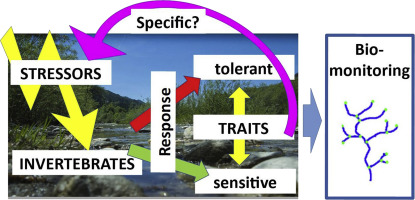Science of the Total Environment ( IF 8.2 ) Pub Date : 2017-11-13 , DOI: 10.1016/j.scitotenv.2017.11.022 Elisabeth Berger , Peter Haase , Ralf B. Schäfer , Andrea Sundermann

|
Monitoring of macroinvertebrate communities is frequently used to define the ecological health status of rivers. Ideally, biomonitoring should also give an indication on the major stressors acting on the macroinvertebrate communities supporting the selection of appropriate management measures. However, most indices are affected by more than one stressor. Biological traits (e.g. size, generation time, reproduction) could potentially lead to more stressor-specific indices. However, such an approach has rarely been tested.
In this study we classify 324 macroinvertebrate taxa as vulnerable (decreasing abundances) or tolerant (increasing abundances) along 21 environmental gradients (i.e. nutrients, major ions, oxygen and micropollutants) from 422 monitoring sites in Germany using Threshold Indicator Taxa Analysis (TITAN). Subsequently, we investigate which biological traits and taxonomic groups are associated with taxa classified as vulnerable or tolerant with regard to specific gradients.
The response of most taxa towards different gradients was similar and especially high for correlated gradients. Traits associated with vulnerable taxa across most gradients included: larval aquatic life stages, isolated cemented eggs, reproductive cycle per year < 1, scrapers, aerial and aquatic active dispersal and plastron respiration. Traits associated with tolerant taxa included: adult aquatic life stages, polyvoltinism, ovoviviparity or egg clutches in vegetation, food preference for dead animals or living microinvertebrates, substrate preference for macrophytes, microphytes, silt or mud and a body size > 2–4 cm.
Our results question whether stressor-specific indices based on macroinvertebrate assemblages can be achieved using single traits, because we observed that similar taxa responded to different gradients and also similar traits were associated with vulnerable and tolerant taxa across a variety of water quality gradients. Future studies should examine whether combinations of traits focusing on specific taxonomic groups achieve higher stressor specificity.
中文翻译:

面向应激源的大型无脊椎动物指数:哪些特征和分类群与脆弱和宽容的分类群相关?
大型无脊椎动物群落的监测通常用于确定河流的生态健康状况。理想情况下,生物监测还应指出作用于无脊椎动物群落的主要压力源,以支持选择适当的管理措施。但是,大多数指数受一个以上压力源的影响。生物学特性(例如大小,世代时间,繁殖)可能会导致更多针对应激源的指标。但是,这种方法很少经过测试。
在这项研究中,我们使用阈值指标分类法分析(TITAN),根据德国422个监测点的21个环境梯度(即营养素,主要离子,氧气和微污染物)将324个大型无脊椎动物分类单元分类为易受攻击(丰度降低)或耐受(增加数量)。随后,我们调查了哪些生物学特性和分类学组别与分类相关的易分类或耐受的分类单元相关。
大多数分类单元对不同梯度的响应是相似的,对于相关梯度尤其如此。在大多数梯度下,与脆弱分类群相关的特征包括:幼体水生生命阶段,孤立的胶结卵,每年<1的繁殖周期,刮刀,空中和水生主动扩散和腹甲呼吸。与耐性类群相关的性状包括:成年水生阶段,植被中的多伏性,卵胎生或卵离合,对死动物或活无脊椎动物的食物偏爱,对大型植物,微植物,淤泥或泥土的底物偏爱以及体型大于2–4 cm。
我们的研究结果质疑是否可以使用单一性状获得基于大型无脊椎动物组合的应激源特异性指标,因为我们观察到相似的分类群对不同的梯度有响应,而且相似的性状与各种水质梯度下的脆弱和耐性分类群相关。未来的研究应检查针对特定分类组的性状组合是否达到较高的应激源特异性。











































 京公网安备 11010802027423号
京公网安备 11010802027423号